Read all the best facts about the second planet from the Sun in our guide to Venus
Venus is the nearest planet to Earth and the two are very similar in size and mass. And yet the two world's couldn't be more different.
Unlike our temperate, life-rich world, Venus is a hellscape – the skies are filled with acid clouds and winds that blow at hundreds of miles per hour, while on the surface it's hot enough to boil lead and the pressure is over 90 times that on Earth.
These differences weren't immediately obvious, however. In many respects, Earth and Venus look very similar.
They seem to be made of more or less the same material, an iron-rich core with a rocky crust, and our best understanding of the history of the Solar System tells us that they formed at the same time, from a primordial cloud of dust and gas surrounding the young Sun, about 4.5 billion years ago.
For these reasons Earth and Venus are often referred to as twin planets. The close similarity between the two makes the differences that do exist all the more interesting.
Venus is closer to the Sun, so we might expect it to be warmer and cloudier. Certainly, the face that Venus presents to an observer using even a modest telescope is shrouded permanently in a thick layer of almost featureless cloud.
Read more guides and facts about planet Venus:
- What did the Venus Express mission discover at Venus?
- A guide to the mountains of Venus
- How to photograph Venus with a digital camera
Early views of Venus
For centuries, people wondered what lay below: seas, deserts, moist steamy jungles, or perhaps all of these.
Even before Venus was visited by the first space probe – Mariner 2 in December 1962 – some clues were starting to emerge.
Radio astronomers turned their large dishes to the planet and found an unexpectedly high level of microwave energy coming from Venus.
It wasn’t clear whether this was thermal emission, which would indicate that Venus was unexpectedly hot, or some kind of auroral effect, lightning, or radiation from particles trapped in some Venusian equivalent of Earth’s Van Allen belts.
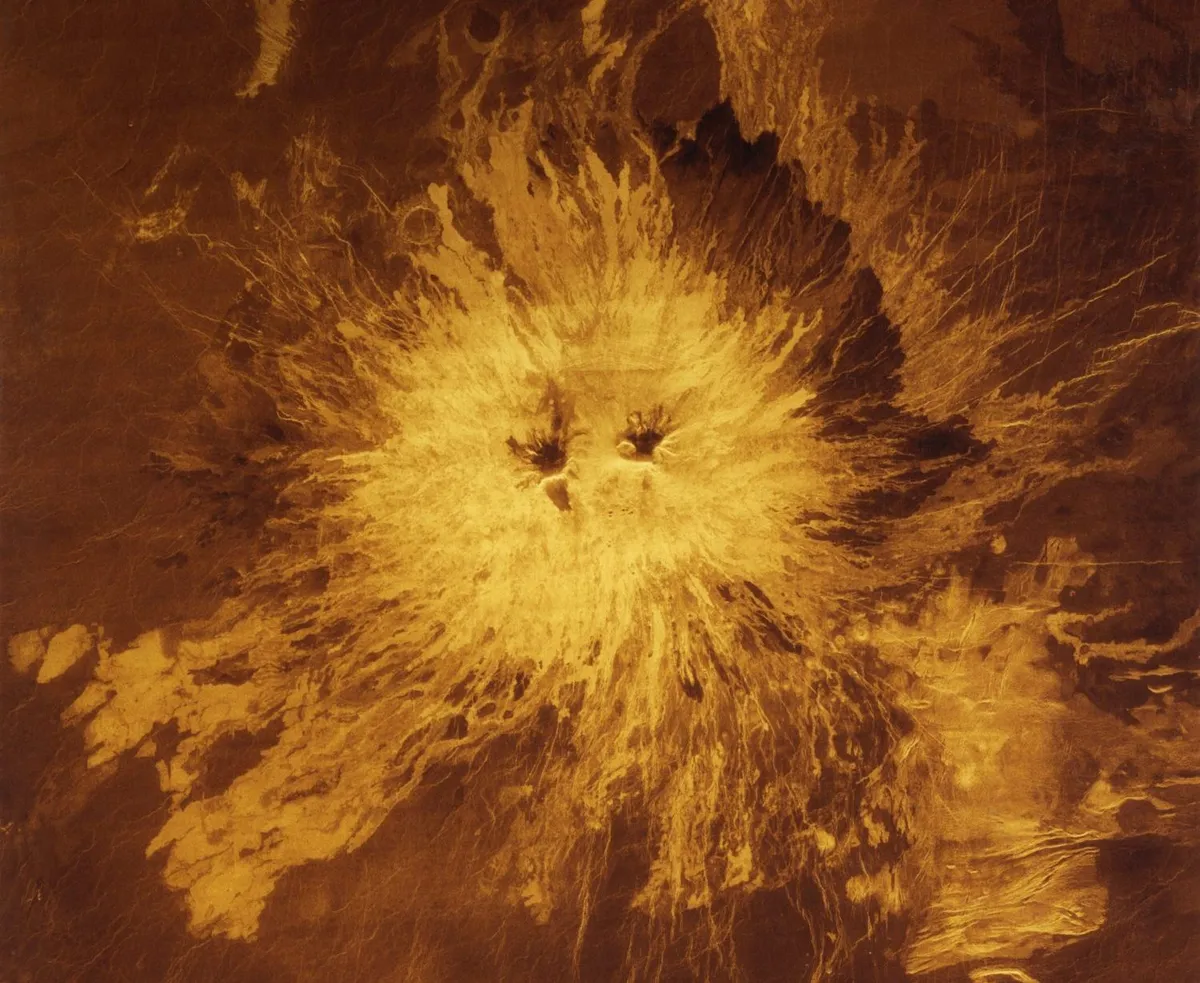
Mariner 2 carried a small microwave radiometer to address this question. The answer was unambiguous.
The emission was from the surface of Venus, it had to be thermal, and the temperature on Venus had to be in the region of 400ºC.
The Soviet's get a closer look at Venus
A few years later, beginning in 1970, several Russian Venera probes landed on Venus and measured the temperature directly.
Not only was it remarkably hot, but the surface pressure was also nearly 100 times higher than on Earth – much higher than anyone had expected.
To add to these differences, spectroscopy from Earth has shown that the abundant clouds on Venus are made up of droplets, not of water but of concentrated sulphuric acid.
Markings appear in the clouds when they are viewed through an ultraviolet filter; these show rapid motions around the equator in organised patterns, indicating high winds and planetary-scale waves and tides.
The speed and consistency of the winds on Venus are surprising, since radar measurements find that the solid planet rotates very slowly compared to Earth: just once every 243 days.
More than 30 spacecraft have now visited Venus, including fly-bys, orbiters and landers, the latter class being short-lived in the extreme conditions found on the surface.
Together, much detail has been added to the picture we have of Venus, including the presence of massive volcanoes and smooth plains on the surface, and the total absence of a planetary magnetic field.
Earth and Venus - two very different twins
There are no oceans on Venus – it is much too hot – and not much water, just a trace of vapour in the atmosphere, and some liquid bound up with sulphuric acid in the cloud droplets.
The rapid ‘super-rotation’ of the atmosphere leads to giant vortices, rather like hurricanes on Earth but larger and more persistent, centred over the north and south poles.
So, while Venus is certainly a near-twin of the Earth in its main attributes, it doesn’t seem to behave like the Earth at all, particularly where the atmosphere and climate are concerned.
Some people refer to the planet, the brightest and most beautiful object in our night sky when the Moon is absent, as an errant or even evil twin, because surface conditions are so hostile to travellers from Earth.
Not even our machines can survive there for long, and the day when humans walk on the surface must be remote indeed.
Would-be space travellers spurn Venus for the frozen wastes of Mars when planning human voyages through space and dreaming of setting up bases and colonies.
We may not be going there in a hurry, but can we explain Venus’s behaviour?

Why is Venus so hostile?
With these new facts to guide us, it is disconcerting our expectations about planet Venus were so wrong.
This is not an abstract concern: it is frequently said that what Venus has is an extreme version of the global warming phenomenon, due to the greenhouse effect produced largely (on both planets) by atmospheric water vapour, cloud and carbon dioxide.
Earth is becoming a little more like Venus, and apparently for the same basic reason: increasing greenhouse gases.
When we analyse the problem, helped by measurements made by the exploration programme mounted by the USA and the USSR since 1962, Venus starts to come into perspective.
The temperature structure of the atmosphere above the one-bar pressure level, where the densities are comparable with Earth, is not very different from what we would expect.
Below that, given that there is more atmosphere made up mostly of carbon dioxide, the temperature must continue to rise.
Eventually, when the pressure reaches about 92 bars at the surface, it exceeds the melting points of metals like lead and tin.
So the surprising thing is not really the temperature, but the mass of the atmosphere – why does Venus have so much more air than we have on Earth?
Venus's absence of oceans
A clue is that while Venus may have a lot of atmosphere, it has no ocean.
If the planets are twins in the sense of forming together and close by, when the Solar System was born – bodies the same size should have had roughly the same allocations of both.
Looking closer, we find that Venus did have oceans of water early on, and the Earth did have plenty more atmospheric carbon dioxide.
What seems to have happened is that the water on Earth condensed into oceans and seas that dissolved much of the carbon dioxide and turned it eventually into carbonate rocks, for instance the limestone in the white cliffs of Dover.
On Venus, the water evaporated faster and was lost from the planet by being dissociated in the upper atmosphere by ultraviolet radiation from the Sun, forming hydrogen and oxygen.
The hydrogen, in particular, can boil off into space. Even the oxygen is relatively easily stripped away by the flow of particles from the Sun – the solar wind – because Venus, unlike Earth, is not protected by a magnetic field.

Evidence of Venus's history
The evolutionary picture in which Venus lost its ocean while Earth lost its carbon dioxide has gained support from various findings.
The ratio of the heavier isotope of hydrogen (deuterium) to the ordinary kind is very high on Venus, in line with the fractionation that is expected if huge amounts of both have been lost to space.
Estimates of the amount of carbon dioxide stored as minerals on Earth have come up with enough to make an atmosphere like Venus if it was released to become a gas again.
The amount of nitrogen in Venus’s atmosphere, although only around 3% of the total, is roughly the same as the amount on Earth, although it is the principal constituent here at about 80%.
Since nitrogen is neither efficiently turned into minerals nor rapidly lost to space, this is in line with expectations.
Hence the modern view that Venus and Earth really are twins, they just grew up differently. We even have a fair idea of why they diverged as they did.
Understanding why the two planets diverged not only tells us more about our own Solar System, but will also help astronomers studying exoplanets to understand whether a rocky planet might be an Earth-like Eden, or a Venusian hellscape.
Guide to planet Venus: top facts
What is the surface of Venus like?
Russian engineers were able to land vehicles on Venus 10 times during the 1970s and 1980s. These were Venera 7 to 14, and Vega 1 and 2.
The Venera landers found that the surface of Venus seemed to be mainly basalt, volcanic igneous rock that is also common on Earth. Radar maps show two continental plateaux, Ishtar and Aphrodite, that occupy around 10% of the planet’s surface. The rest is rolling hills and vast plains suspected of being ancient ocean basins.
Today, the plains are hot (over 400ºC) and dry. Along with most of the planet, they seem to have been resurfaced by lava in the relatively recent geological past, 300 to 500 million years ago.
Venus's atmosphere
Several layers of cloud fill the atmosphere of Venus from about 30–65 km above the surface.
These reveal dramatic weather patterns, different in the high and low cloud layers, that are reminiscent of Earthly weather systems, and yet curiously different.
Mapping these and their changes is a big focus for Venus Express, which recently arrived at the planet.
The European mission has some big advantages over earlier probes: its orbit is ideal for atmospheric studies.
It passes over the north pole to get close to the giant polar vortex and then swings out over the south pole for global coverage.
Even more importantly, it was discovered quite recently that Venus’s clouds are transparent at certain wavelengths in the infrared spectrum.
Now orbiting cameras, spectrometers and radiometers can peer deep into the clouds and all the way down to the surface, all over the planet, as previously only radar could.
The results suggest that Venus’s atmosphere is more stable than Earth’s in its meridional circulation (from equator to pole), but less stable in its zonal behaviour (parallel to the equator), producing the dramatic dynamics seen in the cloud structure.
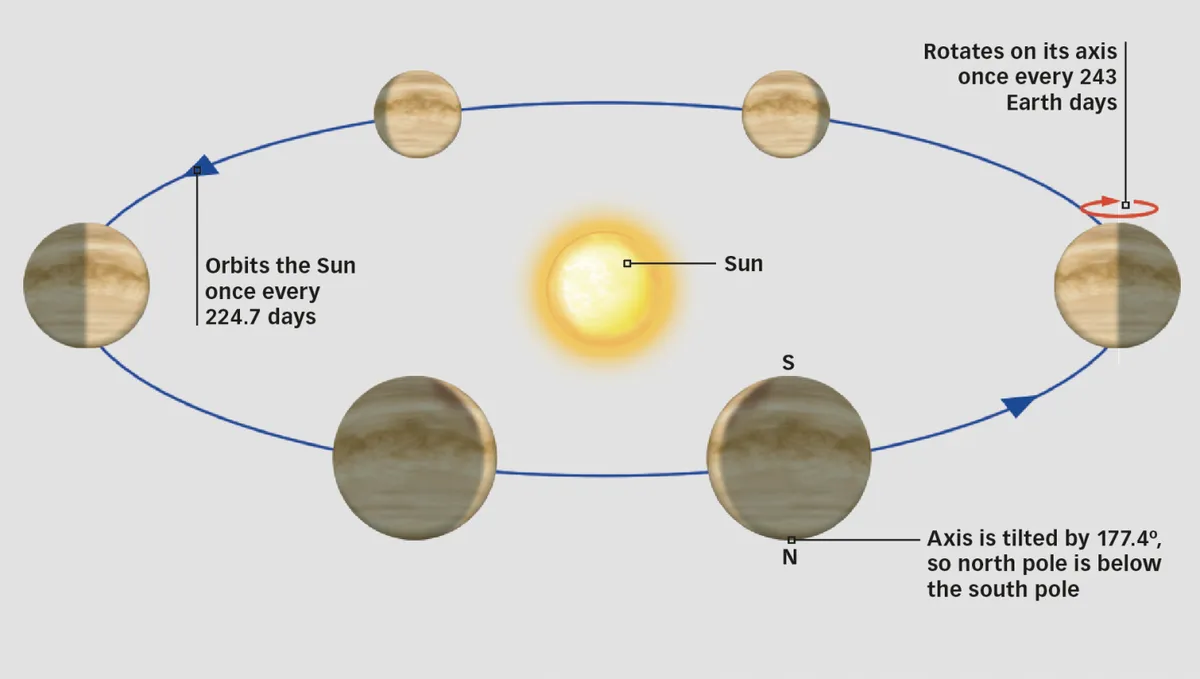
Venus's orbit
Venus rotates clockwise and is a planet with almost no Sun-driven seasonal changes. It orbits the Sun at a mean distance of 108.2 million km, taking 224.7 days to complete its year.
It rotates once every 5,832.5 hours, or 243 Earth days. Hence, a day would be 2,802 hours or 116.75 Earth days long.
The orbit is near circular, with an eccentricity of just 0.007, while an obliquity of 177.4º means that Venus rotates from east to west, in the opposite sense to most other planets, including Earth, and has no seasons.
Venus's volcanoes
Venus is studded with volcanoes and extensively covered with lava flows, many of which extend for great distances.
The atmosphere is full of gases and condensates that contain sulphur compounds; these almost certainly originated in emissions from volcanoes.
However, we have never seen an active volcano on Venus and we don’t know how volcanically active Venus is today.
The fact that Venus has relatively few craters on its surface is attributed to the protection afforded by the thick atmosphere, and to massive flooding by lava in the past.
There is some evidence from crater counts that this resurfacing happened in an isolated episode, around 500 million years ago.
Some scientists think that the planet ‘stores up’ its volcanic activity, and unleashes it all in occasional great surges. Continuous but variable activity is more likely, however.
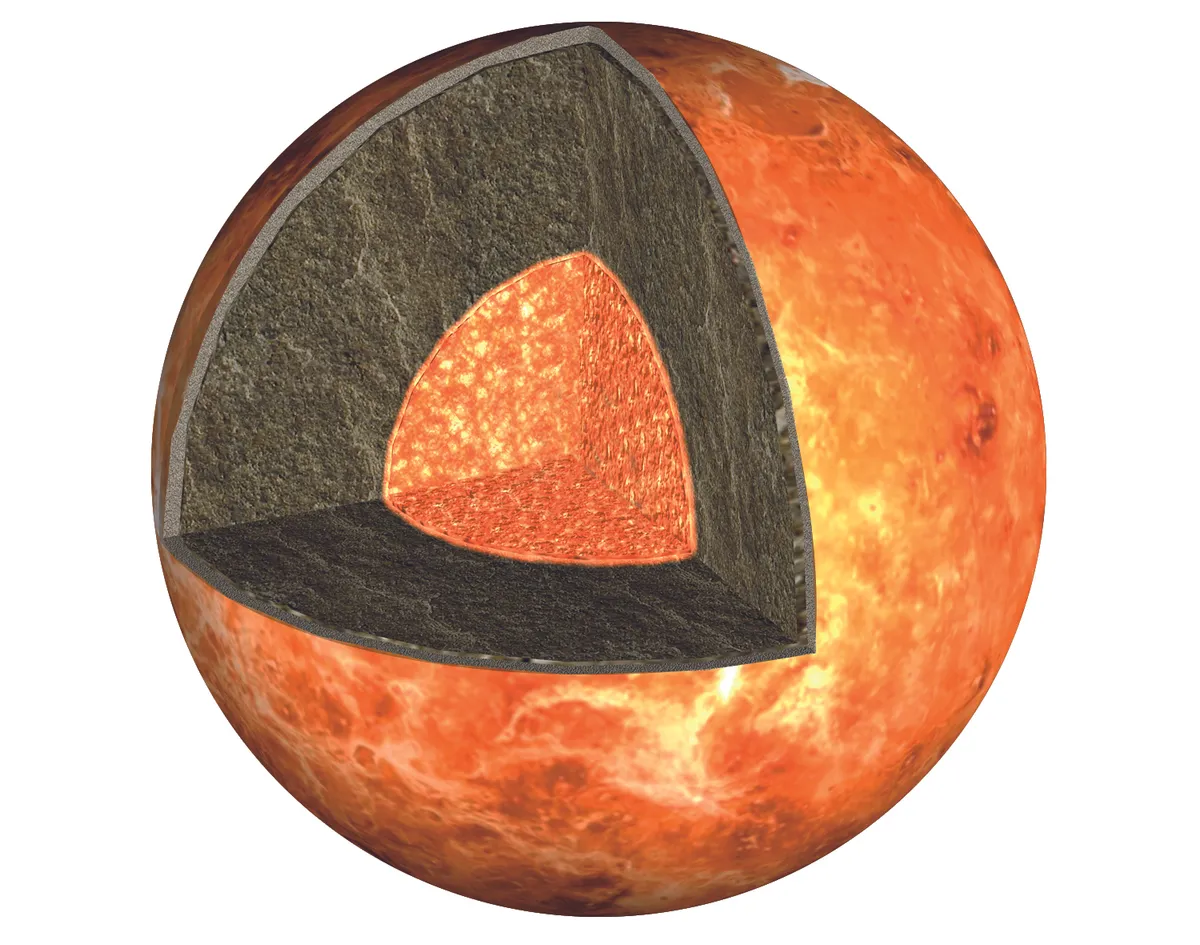
Venus's interior
Venus has about 95% the diameter of Earth and 81% its mass, corresponding to almost the same uncompressed density.
This fact, plus the belief that the terrestrial planets formed together, leads us to expect that, like the Earth, the interior of Venus has a partly molten metallic core, a rocky mantle, and a crust.
Little more is known, but the apparently active volcanism, slow rotation, and absence of a planetary magnetic field may be clues about the interior of Venus that have yet to be interpreted and resolved.
Guide to planet Venus's surface features
River Styx

This channel on Venus is 6,800km long and about 2km wide. Evidently the result of erosion, it is not known what liquid carved it or when in Venus’s history the flow occurred, or even if it continues today.
Maxwell Montes
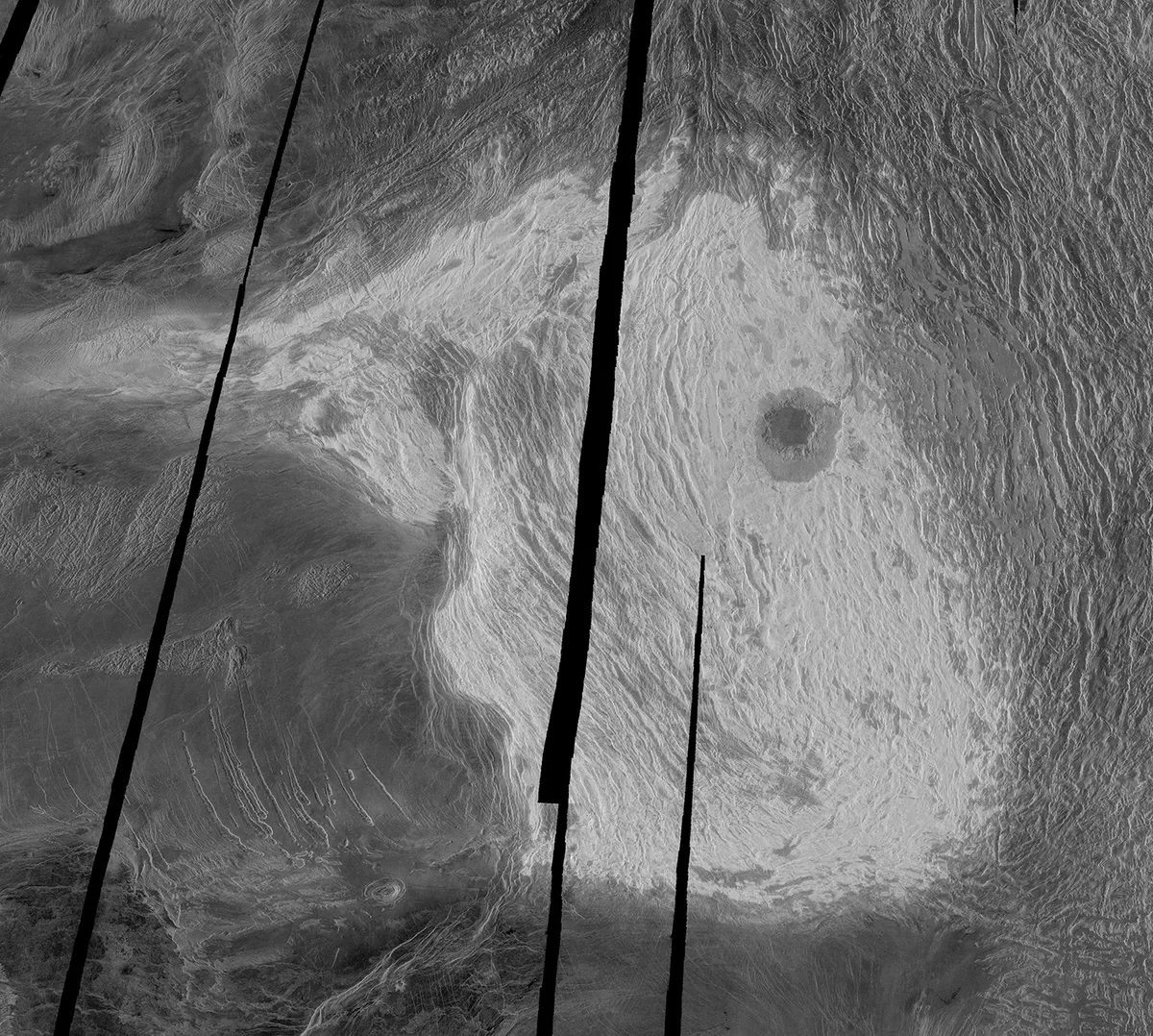
At 11km, Maxwell Montes is the highest mountain on Venus, with gentle slopes on one side and a virtual cliff on the other. The crater near the peak is Cleopatra, which is about 100km in diameter.
Alpha Regio
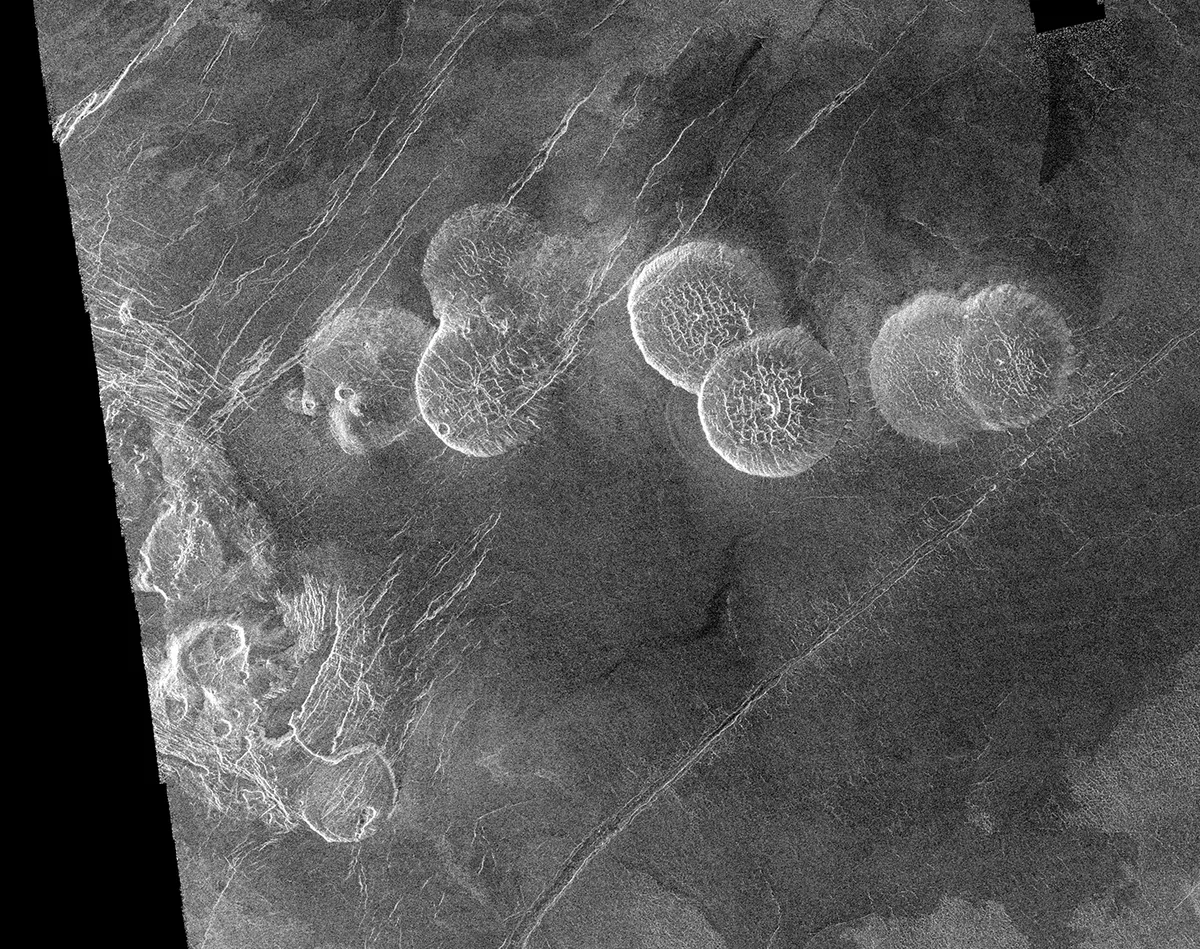
Pancake domes, like those on Alpha Regio, are typically 25km in diameter and 750m high. They form when lava extrudes slowly under the extreme pressure on Venus. A similar thing occurs at the bottom of Earth’s deep oceans.
Aphrodite Terra

Aphrodite Terra is a region of intersecting ridges and valleys about the size of Africa, found in the southern hemisphere of Venus near the equator. The intricate patterns result from forces due to crustal movements in varying directions.
Timeline: uncovering planet Venus's mysteries
c. 4000 BC
The first recorded instance of Venus worship, by the Sumarian people of Mesopotamia who are convinced the planet is a god called Inanna.
1520
Montezuma may have observed the transit of Venus in Mexico, since he certainly made solar observations at this time. The Mayan civilisation associated Venus with its principal god, Quetzalcoatl, and his incarnation, Kulkulkan.
1610
Galileo Galilei is the first to observe the phases of Venus using his refractor, proving that it orbits the Sun, which in turn lends strong support to the heliocentric model of the Solar System.
9 January 1643
Giovanni Riccioli in Bologna reports the first telescopic observation of the ashen light, a faint glow forming patterns on the night side of Venus.
1896
Percival Lowell reports observations of a radial pattern of canals on Venus. However, It is now believed that, because of a deficient observing technique, he was actually seeing the blood vessels in his own retina.
14 December 1962
Mariner 2 becomes the first spacecraft to visit Venus. It scans the planet with powerful infrared and microwave radiometers, revealing that Venus has cool clouds and a hot surface.
15 December 1970
Venera 7 lands at 5°S, 351°E on Venus at 05:34 UT, becoming the first man-made spacecraft to land on another planet and transmit data back to Earth. It confirms the high surface temperature, ranging from 457 to 474ºC.
22 October 1975
Venera 9 orbits Venus and releases a lander that transmits the first picture of the surface back to Earth.
4 December 1978
Pioneer Venus Orbiter becomes the first American artificial satellite of Venus, six weeks after the Russian Venera 9. Its instruments make measurements for a decade until the spacecraft burns up in Venus’s atmosphere in August 1992.
8 June 2004
Venus transits the face of the Sun. The last time this occurred was in 1882, and it happened again in 2012. The next one will be in December 2117.
11 April 2006
The first European mission to Venus, Venus Express, enters orbit and transmits back its first data the following day. Find out what Venus Express discovered here.
Fred is Halley Professor of Physics at Oxford University. This article originally appeared in the July 2006 issue of BBC Sky at Night Magazine.